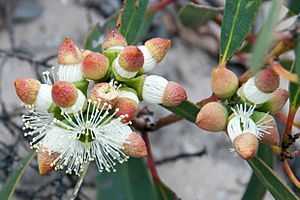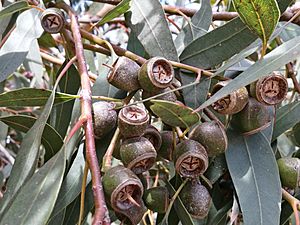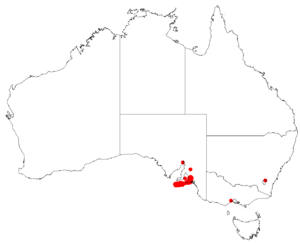Cup gum facts for kids
Quick facts for kids Cup gum |
|
|---|---|
 |
|
| Eucalyptus cosmophylla, Kangaroo Island, SA | |
 |
|
| Eucalyptus cosmophylla, Cranbourne Botanic Gardens, VIC | |
| Scientific classification | |
| Genus: |
Eucalyptus
|
| Species: |
cosmophylla
|
 |
|
| Collections data from AVH | |
| Synonyms | |
|
Eucalyptus cosmophylla F.Muell. f. cosmophylla |
|
The Cup Gum (scientific name: Eucalyptus cosmophylla) is a special type of small tree or mallee that only grows in South Australia. It's also known as bog gum or scrub gum. This plant usually has smooth bark and long, thin leaves. Its flowers are white and grow in groups of three. The fruit looks like a cup, cylinder, or half-sphere.
What Does a Cup Gum Look Like?
The Cup Gum is usually a mallee, which means it has many stems growing from the ground. It can grow to be about 2 to 5 meters (6.5 to 16 feet) tall. Sometimes, it grows as a single-stemmed tree up to 10 meters (33 feet) tall.
Its bark is smooth and pale grey, with white or pink patches. It peels off in flat pieces. Young plants have stems that are almost square. Their first leaves are oval-shaped, about 40 to 90 mm long and 45 to 95 mm wide. These leaves have a small stalk called a petiole.
Adult leaves are thick and dull grey-green on both sides. They are about 80 to 180 mm long and 13 to 50 mm wide. They also have a petiole, which is about 10 to 40 mm long.
The flower buds grow in groups of three on a short stalk called a peduncle. Each bud is either directly attached (called sessile) or has a tiny stalk (a pedicel) up to 6 mm long. Mature buds are oval or pear-shaped, about 11 to 22 mm long and 7 to 15 mm wide. They are green to yellow. The top part of the bud, called the operculum, is usually rounded or cone-shaped.
Cup Gums flower between July and November. Their flowers are white or cream-colored. All the parts that produce pollen, called anthers, are able to create seeds.
After flowering, the plant produces woody fruits. These fruits are shaped like a cup, cylinder, or half-sphere. They are about 9 to 18 mm long and 10 to 22 mm wide. The fruit usually has two ribs and a thick rim. Inside, the brown seeds are shaped like many-sided objects and have narrow wings.
How Did it Get its Name?
The Cup Gum was first officially described in 1855 by a scientist named Ferdinand von Mueller. He found specimens of this plant in the Lofty and Bugle Ranges.
The scientific name, cosmophylla, comes from two Ancient Greek words:
- kosmos, which means "ornament" or "decoration"
- phyllon, which means "leaf"
So, cosmophylla basically means "ornamental leaf" or "decorated leaf," referring to its distinctive leaves.
Where Does it Grow?
The Cup Gum grows close to the sea in areas with open shrubs, open forests, and heathlands. It usually prefers soils that are not very fertile. You can find it in the southern part of the Lofty Ranges, on the Fleurieu Peninsula, and on Kangaroo Island in South Australia.

